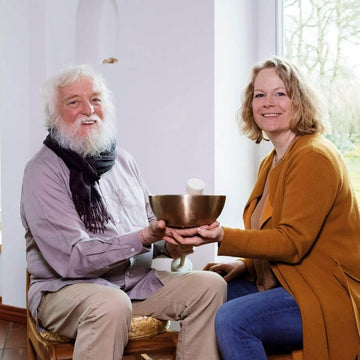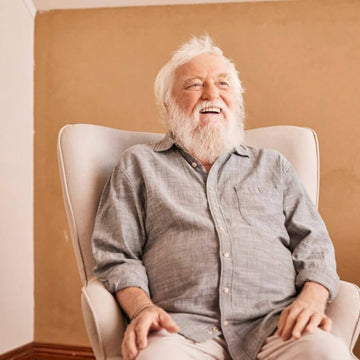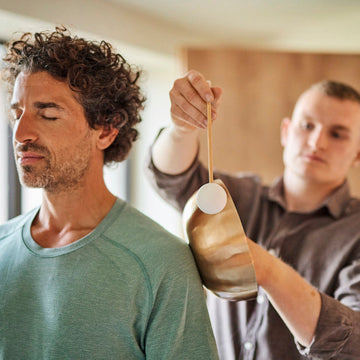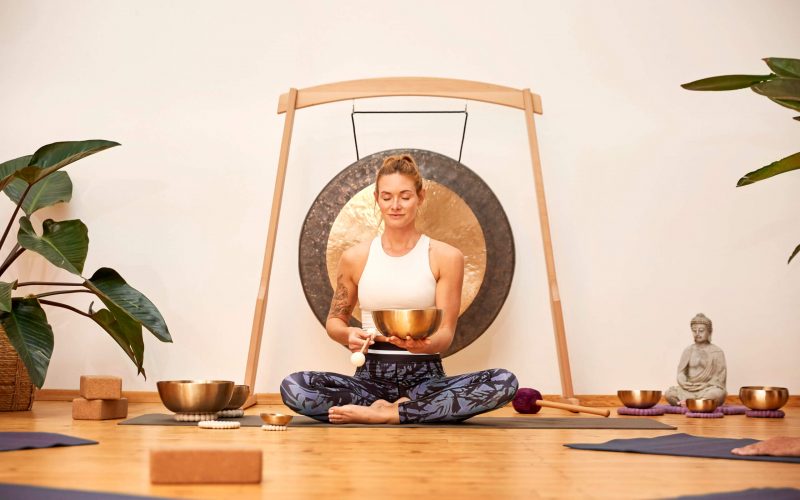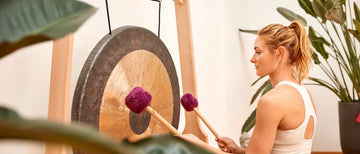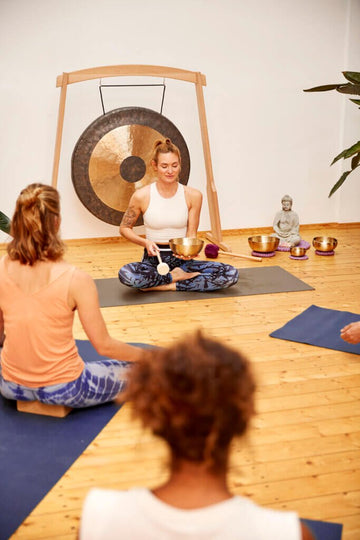
Key points at a glance
- During a Singing Bowl meditation, the Singing Bowl helps you to let go of your thoughts.
- All you need is a Singing Bowl, a mallet, comfortable clothing, and a quiet space.
- With a little practice, meditation with Singing Bowls leads to deep relaxation for body and mind.
- In a Gong meditation, a unique tapestry of sound is created, which puts the participants in a trance.
- In this state, deep-seated blockages can be released.
- Through the combination of yoga and sound, you develop a better feeling for your body and deeply relax into the asanas.
- In Sound Yoga, both Singing Bowls and Gongs are used.
What is a Singing Bowl Meditation?
In a meditation with Singing Bowls, you usually meditate while sitting and use the Singing Bowl as support to reach a state of inner stillness. Singing Bowl meditation can help you find easier access to meditation, as the sounds already put us in a relaxed state of consciousness.
Those who already have some experience in meditation with Singing Bowls perceive the familiar sound as a trigger that automatically directs attention inwards. Through a regular meditation practice, you will find new clarity and detach yourself from ingrained patterns of thought and action.
Is Singing Bowl meditation for me?
Meditation with Singing Bowls is easy to learn, so you can practice it even if you don't have much experience with Singing Bowls or meditation. If you want to practice Singing Bowl meditation at home on your own, it only takes a little practice, as the goal is to strike the bowl yourself during meditation without being pulled out of your meditative immersion.
The only requirement you should bring is curiosity and openness to sounds and vibrations. When you perform the Singing Bowl meditation is up to you. Some people like to start directly in the morning with a meditation to face the challenges of the day with inner serenity. Others prefer to use meditation with Singing Bowls in the evening to end the day and come to rest.
Note
Meditation with Singing Bowls can also be performed by sick or physically impaired people, as it is possible both sitting on the floor and on a chair.
How does Singing Bowl meditation work?
First of all, you need a Singing Bowl. Once you have found the right model for you, you can get started.
Find a quiet place
It is best to find a quiet, undisturbed place and sit on a yoga mat or meditation cushion, or simply on a blanket. Turn off your cell phone and make sure that no one disturbs you for the next 10 to 15 minutes.
Place your Singing Bowl
Now place the Singing Bowl in front of you so that you can comfortably strike it from your sitting position. You can also place the bowl on your flat hand or on your fingertips. The only important thing is that the sides of the Singing Bowl are not dampened by your hand or materials. The bowl should be able to vibrate freely. A Singing Bowl pad is also ideal.
Focus on your breath
Close your eyes and focus only on your breathing to calm down and relax. Only in this state do you begin to gently strike the Singing Bowl with a mallet. You can find out exactly how to do this in our article on Singing Bowl application. If you would like to learn more about the different types of mallets, we recommend our mallet guide.
Focus your attention on the vibrations
Listen to the sound and feel the vibrations and direct your full attention to it. Imagine how the sound waves flow through your body. You can also concentrate on one part of your body and see what effect the sound and vibrations have on that one part. Let the bowl fade away completely before you strike it again. Focusing on the sound helps you to ignore emerging thoughts.
Notice and slowly come back.
To end the meditation, feel the last sound for a little while and keep your eyes closed. Finally, take a few deep breaths in and out, then open your eyes again.
Caution: During pregnancy and in case of acute physical or psychological complaints, please only use after consulting your doctor.
What do I need for a Singing Bowl meditation?
- Singing Bowl
- Mallets & friction mallets
- Singing Bowls coaster
- Mat, meditation cushion, blanket, etc.
- Comfortable clothing
- Peace and quiet
What are the effects of a Singing Bowl meditation?
With a little practice, meditation with Singing Bowls leads to deep relaxation for body and mind. This allows you to reduce stress and recharge your energy and strength. A Singing Bowl meditation can calm your heartbeat and breathing. Satisfaction, joy of life and creativity increase. Tension and blockages in the body can be released.
In addition to the physical level, Qi, the life energy, is activated and stimulated on the spiritual level. Depending on the pitch of the Singing Bowl, different chakras or energy centers of the body are addressed. A Singing Bowl meditation can have a positive influence on the entire nervous system.
In our video, Peter Hess talks about his personal first experiences with sound meditations and the impressive effect they had on his body and mind.
The positive effects of meditation include:
- Targeted stress reduction and prevention of burnout
- Greater physical and mental resilience
- More balance and inner peace
- Greater ability to concentrate and motivation
- More self-confidence, inner strength and personal appreciation
- More joy in life
What is a Gong Meditation?
The Gong is an ancient instrument with a long tradition. Its broad spectrum of sounds fascinates and inspires more and more people. The TamTam Gong impresses with its intense sound volume and the Feng Gong with its "wind-like" sound movement. In addition to concerts, the gong is also used in sound massage, in sound therapy and sound education, and last but not least in meditation. Gong meditation carries a wonderful potential for intensive self-experience.
A Gong meditation is often offered in conjunction with Kundalini yoga. After yoga, participants lie on their mats and surrender to the intense Gong sounds played by the teacher. Our human body consists largely of water, which is set in motion by the Gong. It slows down the frequency in the body and brain, putting participants in a state of trance. A Gong meditation primarily helps us to detach ourselves from our thoughts.
How is the Gong played during a Gong meditation?
In the traditional way, the Gong is played in such a way that the individual strokes are not heard, but the Gong is made to sing. A Gong meditation is characterized by this very special type of sound: The Gong strike goes into the room, comes back as an echo and connects with the next sound. This creates a unique tapestry of sound that gradually puts the participants into a trance.
It begins with gentle, quiet vibrations that gradually transition into an ever-higher sound intensity. The teacher not only increases the striking force, but also switches from soft to hard Gong mallets. The Gong meditation can be particularly intense through the use of several Gongs that are played together. The term Gong bath is also frequently used here.
How does a Gong meditation work?
The sound, which is not only perceived through the ears during a Gong meditation, but is also physically palpable, helps us to relax deeply. In this state, emotions, old injuries, but also feelings of happiness can come to the surface and be processed. Therefore, the Gong is considered one of the most powerful instruments with a healing effect in a state of trance.

Tip
If you want to explore Gong meditation at home, you can get a wonderful impression from the CD Pravaaha by Peter Gabis. Here, the meditative sound moods combine with gongs and Singing Bowls to create a flow of sounds.
What is Singing Bowl Yoga?
Yoga and sound have been connected for thousands of years. Through the additional sound component, Yoga with Singing Bowls gains an even deeper quality and promotes an intensive encounter with oneself. Singing Bowl Yoga appeals to people on a physical, emotional, and spiritual level and inspires them to let go with joy.
With Singing Bowl Yoga, it is much easier to focus attention on the body. This allows you to develop a better sense of your body's needs and relax deeply into the asanas. Through the sound, you can engage with your yoga practice in a completely new way and enjoy it with all your senses.
How does Singing Bowl Yoga work?
The bowls used in singing bowl yoga can be struck by the teacher or by the yoga practitioners themselves. The pelvic and heart bowls of the Peter Hess® Therapy Singing Bowls are mainly used, supplemented by Sangha Meditation Singing Bowls. The deep sounds support grounding and releasing exercises, while the higher sounds are mainly used for upright and opening exercises. The Singing Bowls can be placed next to the body, on the body or moved in the body's environment. The bowls are often struck alternately.
"In sound yoga, two wonderful forces combine: relaxation and conscious perception of harmony."
Remo Rittiner, Yoga Therapist
Exercise: Yin Yoga with Singing Bowls
- After a Yin Yoga sequence, lie down in Shavasana and place a Singing Bowl, ideally a pelvic bowl, on your lower abdomen.
- Now strike it and feel how the gentle vibration of the Singing Bowl spreads throughout your body.
- Feel whether the sound allows you to further deepen the relaxation that has arisen from the individual Yin Yoga exercises.
- Strike the Singing Bowl several more times to banish the last thoughts from your head.
- Concentrate entirely on the vibration of the Singing Bowl to prevent any further thoughts from arising. Let yourself fall deeply into the sound.
- Now put the mallet aside and feel the effects for a few more minutes.
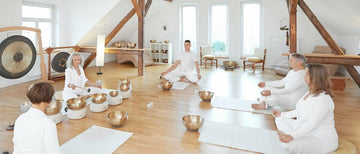
What is Gong Yoga?
The gong is considered one of the most powerful instruments – to let it sound room-filling and gentle at the same time during yoga class, one should know its effect and playing techniques well. Unlike the gong meditation mentioned above in connection with Kundalini Yoga, the gong does not always have to be played loudly and powerfully. In Emily Hess's Gong Yoga, for example, you will learn a gentler way of playing the gong.
Emily Hess conveys the special connection between gongs and yoga in an empathetic, playful, yet structured way, so that participants learn to use the gong effectively and responsibly. Feel free to be inspired by different teachers and teachings, techniques and playing styles, so that you can develop your own unique playing style.
How does Gong Yoga work?
In Gong Yoga, the sound and vibration of the gong are combined with the methodology of yoga, with the aim of energizing and facilitating the energy movement (Prana) in the body. Emily Hess does not experiment with the gong strike in her teaching, but rather structures the asana sequences according to the five rhythms of music therapy according to Gabrielle Roth. In this way, even beginners can safely use the gong in yoga.
Through different striking rhythms and their vibration, the different effects of Gong Yoga on mind and body become noticeable. For yoga teachers, the gong is a great enrichment – both for themselves and for their yoga classes.

